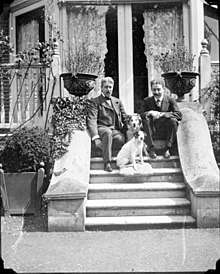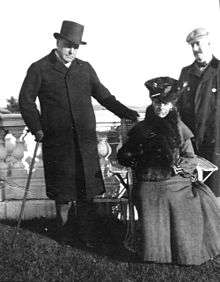Howard Sturgis
Howard Overing Sturgis (January 30, 1855 – February 7, 1920) was an English-language novelist who wrote about same-sex love. Of American parentage, he lived and worked in Britain.
Howard Sturgis | |
|---|---|
 Sturgis and William Haynes Smith with two dogs at Queen's Acres, Windsor, before 1920 | |
| Born | Howard Overing Sturgis January 30, 1855 London, England |
| Died | February 7, 1920 (aged 65) Windsor, Berkshire, England |
| Nationality | British |
| Education | Eton College Trinity College, Cambridge |
| Notable works | Tim: A Story of School Life, All that was possible, Belchamber |
| Partner | William Haynes-Smith |
Early life
"Howdie," as he was known to his intimates, was born in London on 30 January 1855 into an affluent New England American family.[1] His father, Russell Sturgis,[2] was a China trader and lawyer who later became head of Barings Bank in London.[3] His mother was Russell's third wife, Julia Overing (née Boit) Sturgis. Among his siblings were brothers Julian (who also became a novelist) and Henry (who became MP for South Dorset) and sister Mary (wife of Bertram Falle, 1st Baron Portsea).[4] From his father's earlier marriage, he had an elder half-brother, John Hubbard Sturgis, who was a noted Boston architect.[5]
He was described as "a delicate child, closely attached to his mother, and fond of such girlish hobbies as needlepoint and knitting, which he continued to practice throughout his life."[6] His parents sent him to be educated at Eton College. He went on to study at Trinity College, Cambridge, where he graduated with a BA degree in 1878.[7] He became a friend of the novelists Henry James and Edith Wharton.[6]
Career

Sturgis's first novel, Tim: A Story of School Life (1891), was published anonymously and was dedicated to the "love that surpasses the love of women." It describes the love of two youths at boarding-school and was "based on his unhappy days at Eton."[6] It was followed in 1895 by All that was possible, an epistolary novel about an actress who retires from London to a remote valley in Wales.[8]
Sturgis' first two novels were successful as far as sales were concerned; but his third, Belchamber (1904), failed to gain the same plaudits.[6][9] Although Edith Wharton praised it, Henry James found it unsatisfactory,[10] and let Sturgis know in several letters. Afterwards Sturgis went on to publish only one short story (1908), about a lesser writer driven suicidal by the criticism of a greater, and a memorial on his friend, Anne Thackeray.[8]
Personal life
After the death of his mother in 1888, he bought a country house named Queen's Acre ("Qu’acre"), near Windsor Great Park and moved there with his lover, William Haynes-Smith (1871–1937), known to all as "the Babe."[8] Haynes-Smith was the son of the English colonial administrator Sir William Haynes-Smith. At Qu’acre, they frequently entertained a wide group of friends, including Wharton, James and the translator Gerard Hopkins.[6]
Sturgis died at Windsor, Berkshire on 7 February 1920.[10] Four years after his death, Haynes-Smith married Howard's niece, Alice Maud Russell Sturgis (a daughter of his elder half-brother John Hubbard Sturgis),[11] at Manchester-by-the-Sea, Massachusetts. Both were in their 50s when they married.[12]
Legacy
After his death appreciations of him were published by A. C. Benson (1924), Edith Wharton (1934), E. M. Forster (1936) and George Santayana (1944), his cousin. His great-nephew is the journalist and novelist Henry Porter.
Works
- Tim: A Story of School Life (1891) [Anonymously published]
- All That Was Possible (1895)
- Belchamber (1904)
- 'On the Pottlecombe Cornice', in Fortnightly Review (1908) [short story]
Further reading
- M. Seymour, A Ring of Conspirators: Henry James and his literary circle (1986)
- E. Borklund, 'Howard Sturgis, Henry James and Belchamber ', in Modern Philology; 58 (1961), p. 255-269
- George Santayana, Persons and Places (1944; repr. 1986)
- E. M. Forster, 'Howard Overing Sturgis', in Abinger Harvest (1936), p. 121-129
- Edith Wharton, A Backward Glance (1934; repr. 1985)
- A. C. Benson, Memories and friends (1924)
References
- Roberts, Oliver Ayer (1898). History of the Military Company of the Massachusetts, Now Called the Ancient and Honorable Artillery Company of Massachusetts. 1637-1888. A. Mudge & son, printers. p. 75. Retrieved 1 April 2020.
- "WILLS AND BEQUESTS". The Star. 3 January 1888. p. 4. Retrieved 1 April 2020.
- White, Edmund (6 March 2008). "Portrait of a Sissy". The New York Review of Books. ISSN 0028-7504. Retrieved 1 April 2020.
- Lee, Sir Sidney (1912). Dictionary of National Biography: Neil-Young. Macmillan. p. 451. Retrieved 1 April 2020.
- Boit, Robert Apthorp (2009). Chronicles of the Boit Family and Their Descendants and of Other Allied Families. Bibliobazaar. ISBN 978-1-113-65501-1.
- "Howard Sturgis". www.nybooks.com. New York Review Books. Retrieved 1 April 2020.
- "Sturgis, Howard Overing (STRS874HO)". A Cambridge Alumni Database. University of Cambridge.
- Hollinghurst, Alan (9 October 2008). "Don't Ask Henry: Sissiness". London Review of Books. Retrieved 1 April 2020.
- "A Tragedy of Misguidedness.; BELCHAMBER. By Howard Overing Sturgis, Author of "Tim" and "All That Was Possible." 12mo. Pp. 360. New York: G.P. Putnam's Sons". The New York Times. 10 June 1905. Retrieved 1 April 2020.
- Borklund, Elmer. "Howard Sturgis, Henry James, and Belchamber". Modern Philology, Vol. 58, No. 4 (May, 1961)
- "Died". The New York Times. 29 October 1964. Retrieved 1 April 2020.
- "HAYNES-SMITH -- STURGIS". The New York Times. 23 June 1924. Retrieved 1 April 2020.
External links
- GLBTQ.com
- Works by or about Howard Sturgis at Internet Archive
- Works by Howard Sturgis at LibriVox (public domain audiobooks)
